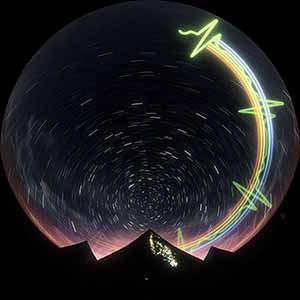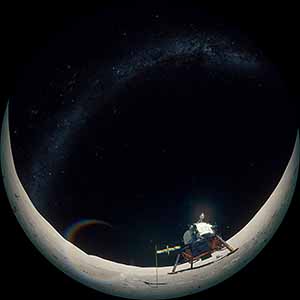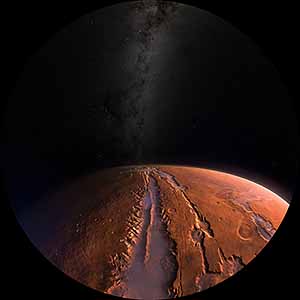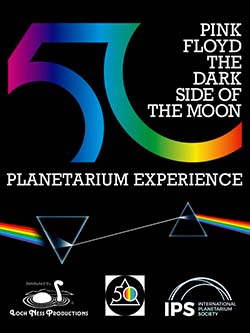The Dark Side Of The Moon Planetarium Experience
Celebrate the 50th anniversary of the album!
Pink Floyd’s iconic album The Dark Side Of The Moon, originally released in March 1973, turns 50, and what more fitting a place to celebrate it and experience it than in a Planetarium, through the music set to visuals. With the help of modern technology, the idea of a show combining breath-taking views of the solar system and beyond, played out to 42 minutes of The Dark Side Of The Moon in surround sound, has been embraced by the band. NSC Creative have led the visual production efforts, working closely with Pink Floyd's long time creative collaborator Aubrey Powell from Hipgnosis.
 On February 27th 1973, EMI Records held a press conference for the debut presentation of Pink Floyd's new album The Dark Side Of The Moon at the London Planetarium. There was already a buzz in the music biz that the album was something very special, and invites for London's press and media were at a premium — there being only so many seats in the theatre. The group, who were renowned for shunning publicity, were expected to make an appearance, given the excitement surrounding the release, which only added to their guests' anticipation. It was felt the planetarium as a backdrop for the 42-minute playback was a suitable venue for Britain's number one 'psychedelic space rock' band — a title they disliked and hoped the new record would put paid to that misnomer. Although the planetarium dome could only show an array of stars, constellations and images of the cosmos whilst the music played, it probably wouldn't help to dispel the myth, which didn't go unnoticed by the members of Pink Floyd. The invitation had a photograph of the Pyramids of Giza in Cairo on the front, which many believed was the album cover, and led to further speculation as to what the enigmatic band were up to now. It was all a deceit.
On February 27th 1973, EMI Records held a press conference for the debut presentation of Pink Floyd's new album The Dark Side Of The Moon at the London Planetarium. There was already a buzz in the music biz that the album was something very special, and invites for London's press and media were at a premium — there being only so many seats in the theatre. The group, who were renowned for shunning publicity, were expected to make an appearance, given the excitement surrounding the release, which only added to their guests' anticipation. It was felt the planetarium as a backdrop for the 42-minute playback was a suitable venue for Britain's number one 'psychedelic space rock' band — a title they disliked and hoped the new record would put paid to that misnomer. Although the planetarium dome could only show an array of stars, constellations and images of the cosmos whilst the music played, it probably wouldn't help to dispel the myth, which didn't go unnoticed by the members of Pink Floyd. The invitation had a photograph of the Pyramids of Giza in Cairo on the front, which many believed was the album cover, and led to further speculation as to what the enigmatic band were up to now. It was all a deceit.
 As the audience faithfully arrived at 3pm sharp they were met not by the band but by four life-sized cardboard cutouts of Pink Floyd, in defiance to EMI's wishes for them to attend and in protest at the venue. One member did turn up — Richard Wright the keyboardist — who had not received the message of a boycott. He hastily beat a retreat when he realised he was alone. The event was an unmitigated success and the album went on to sell over 50 million copies to date.
As the audience faithfully arrived at 3pm sharp they were met not by the band but by four life-sized cardboard cutouts of Pink Floyd, in defiance to EMI's wishes for them to attend and in protest at the venue. One member did turn up — Richard Wright the keyboardist — who had not received the message of a boycott. He hastily beat a retreat when he realised he was alone. The event was an unmitigated success and the album went on to sell over 50 million copies to date.
 Fifty years on, in recognition of Pink Floyd's iconic album, what more fitting a place to celebrate and replay the music set to visuals than a planetarium. Much water has passed under the bridge since the premiere in 1973, and in retrospect, the brilliance of the band's non appearance at London's Planetarium raised more bylines in the press and accolades for the music than the distraction of their presence to promote the album. Forever anti-establishment and so typical of Pink Floyd's recipe for success by not kowtowing to the norm and always bucking the system, this attitude was to continue for the rest of their career.
Fifty years on, in recognition of Pink Floyd's iconic album, what more fitting a place to celebrate and replay the music set to visuals than a planetarium. Much water has passed under the bridge since the premiere in 1973, and in retrospect, the brilliance of the band's non appearance at London's Planetarium raised more bylines in the press and accolades for the music than the distraction of their presence to promote the album. Forever anti-establishment and so typical of Pink Floyd's recipe for success by not kowtowing to the norm and always bucking the system, this attitude was to continue for the rest of their career.
 With the help of modern technology, the idea of a revised show at 100 Planetariums around the world combined with stunning visuals — still the solar system and beyond — played out to 42 minutes of The Dark Side Of The Moon — appealed to Pink Floyd. There will still certainly be a 'no-show' from the band, but there may be cardboard cutouts to remind the audience who Pink Floyd are, and just how significant a role the planetarium played in the history of the record. It's a 50th anniversary for the planetarium event too, only global this time, not just in London.
With the help of modern technology, the idea of a revised show at 100 Planetariums around the world combined with stunning visuals — still the solar system and beyond — played out to 42 minutes of The Dark Side Of The Moon — appealed to Pink Floyd. There will still certainly be a 'no-show' from the band, but there may be cardboard cutouts to remind the audience who Pink Floyd are, and just how significant a role the planetarium played in the history of the record. It's a 50th anniversary for the planetarium event too, only global this time, not just in London.
 The show itself is divided between the 10 tracks of the album, and in chronological order, each having a different theme; some futuristically looking forward and some a retro acknowledgment to Pink Floyd's visual history, all relating to a time and space experience, embracing up-to-the-minute technology that only a planetarium can offer. In the modern parlance it's truly immersive; an all-encompassing surround sound and visual treat that will transcend reality and take you way beyond the realms of 2D experience.
The show itself is divided between the 10 tracks of the album, and in chronological order, each having a different theme; some futuristically looking forward and some a retro acknowledgment to Pink Floyd's visual history, all relating to a time and space experience, embracing up-to-the-minute technology that only a planetarium can offer. In the modern parlance it's truly immersive; an all-encompassing surround sound and visual treat that will transcend reality and take you way beyond the realms of 2D experience.


Running time: 44:09
Suitable for: General Public
Music by: Pink Floyd
Year of production: 2023



